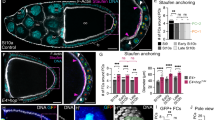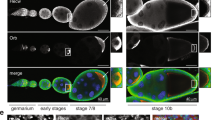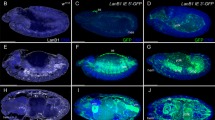Abstract
Here we show that the Drosophila homologue of Lissencephaly-1 , DLis-1, acts together with Bicaudal-D (Bic-D), Egalitarian (Egl), dynein and microtubules to determine oocyte identity. DLis-1 is further required for nurse-cell-to-oocyte transport during oocyte growth, and for the positioning of the nucleus in the oocyte. Immunostaining of DLis-1 protein reveals a cortical localization that is independent of microtubules. DLis-1 may function in this position as a cortical anchor for the other nuclear-localization factors. DLis-1 and Bic-D are further required for nuclear localization in the developing nervous system, indicating that homologues of Bic-D, dynein and Egl-like proteins may also be involved in vertebrate neural migration and that their absence may cause a Miller–Dieker-like lissencephaly.
This is a preview of subscription content, access via your institution
Access options
Subscribe to this journal
Receive 12 print issues and online access
$209.00 per year
only $17.42 per issue
Buy this article
- Purchase on Springer Link
- Instant access to full article PDF
Prices may be subject to local taxes which are calculated during checkout






Similar content being viewed by others
References
Mach, J. M. & Lehmann, R. An Egalitarian-BicaudalD complex is essential for oocyte specification and axis determination in Drosophila . Genes Dev. 11, 423– 435 (1997).
Swan, A. & Suter, B. Role of Bicaudal-D in patterning the Drosophila egg chamber in mid-oogenesis. Development 122, 3577–3586 ( 1996).
Cooley, L. & Theurkauf, W. E. Cytoskeletal functions during Drosophila oogenesis. Science 266, 590– 596 (1994).
Ran, B., Bopp, R. & Suter, B. Null alleles reveal novel requirements for Bic-D during Drosophila oogenesis and zygotic development. Development 120, 1233–1242 (1994).
Schupbach, T. & Wieschaus, E. Female sterile mutations on the second chromosome of Drosophila melanogaster. II. Mutations blocking oogenesis or altering egg morphology. Genetics 129, 1119–1136 (1991).
Lin, H., Yue, L. & Spradling, A. C. The Drosophila fusome, a germline-specific organelle, contains membrane skeletal proteins and functions in cyst formation . Development 120, 947– 956 (1994).
de Cuevas, M., Lee, J. K. & Spradling, A. C. Alpha-spectrin is required for germline cell division and differentiation in the Drosophila ovary. Development 122, 3959–3968 ( 1996).
McGrail, M. & Hays, T. S. The microtubule motor cytoplasmic dynein is required for spindle orientation during germline cell divisions and oocyte differentiation in Drosophila. Development 124, 2409–2419 (1997).
Koch, E. A. & Spitzer, R. H. Multiple effects of colchicine on oogenesis in Drosophila: induced sterility and switch of potential oocyte to nurse-cell developmental pathway. Cell Tissue Res. 228, 21–32 (1983).
Theurkauf, W. E., Smiley, S., Wong, M. L. & Alberts, B. M. Reorganization of the cytoskeleton during Drosophila oogenesis: implications for axis specification and intercellular transport. Development 115, 923–936 (1992).
Pokrywka, N. J. & Stephenson, E. C. Microtubules mediate the localization of bicoid RNA during Drosophila oogenesis . Development 113, 55–66 (1991).
Clark, I., Giniger, E., Ruohola-Baker, H., Jan, L. Y. & Jan, Y. N. Transient posterior localization of a kinesin fusion protein reflects anteroposterior polarity of the Drosophila oocyte. Curr. Biol. 4, 289– 300 (1994).
Pokrywka, N. J. & Stephenson, E. C. Microtubules are a general component of mRNA localization systems in Drosophila oocytes. Dev. Biol. 167, 363– 370 (1995).
Reiner, O. et al. Isolation of a Miller-Dieker lissencephaly gene containing G protein beta-subunit-like repeats. Nature 364, 717–721 (1993).
Xiang, X., Osmani, A. H., Osmani, S. A., Xin, M. & Morris, N. R. NudF, a nuclear migration gene in Aspergillus nidulans, is similar to the human LIS-1 gene required for neuronal migration. Mol. Biol. Cell 6, 297–310 (1995).
Geiser, J. R. et al. Saccharomyces cerevisiae genes required in the absence of the CIN8-encoded spindle motor act in functionally diverse mitotic pathways. Mol. Biol. Cell 8, 1035– 1050 (1997).
Neer, E. J. & Smith, T. F. G protein heterodimers: new structures propel new questions. Cell 84, 175– 178 (1996).
McGrail, M. et al. Regulation of cytoplasmic dynein function in vivo by the Drosophila Glued complex. J. Cell Biol. 131, 411–425 (1995).
Li, M., McGrail, M., Serr, M. & Hays, T. S. Drosophila cytoplasmic dynein, a microtubule motor that is asymmetrically localized in the oocyte. J. Cell Biol. 126, 1475– 1494 (1994).
Rasmusson, K., Serr, M., Gepner, J., Gibbons, I. & Hays, T. S. A family of dynein genes in Drosophila melanogaster . Mol. Biol. Cell 5, 45– 55 (1994).
Rakic, P. Principles of neural cell migration. Experientia 46 , 882–891 (1990).
Tomlinson, A. The cellular dynamics of pattern formation in the eye of Drosophila. J. Embryol. Exp. Morphol. 89, 313– 331 (1985).
Fan, S. S. & Ready, D. F. Glued participates in distinct microtubule-based activities in Drosophila eye development. Development 124, 1497–1507 (1997).
Reinsch, S. & Gonczy, P. Mechanisms of nuclear positioning . J. Cell Sci. 111, 2283– 2295 (1998).
Wang, D. S. et al. Binding of pleckstrin homology domains to WD40/beta-transducin repeat containing segments of the protein product of the Lis-1 gene. Biochem. Biophys. Res. Commun. 209, 622– 629 (1995).
Holleran, E. A., Tokito, M. K., Karki, S. & Holzbaur, E. L. Centractin (ARP1) associates with spectrin revealing a potential mechanism to link dynactin to intracellular organelles. J. Cell Biol. 135, 1815–1829 (1996).
Karki, S. & Holzbaur, E. L. Cytoplasmic dynein and dynactin in cell division and intracellular transport. Curr. Opin. Cell Biol. 11, 45–53 ( 1999).
Suter, B. & Steward, R. Requirement for phosphorylation and localization of the Bicaudal-D protein in Drosophila oocyte differentiation . Cell 67, 917–926 (1991).
Sapir, T., Elbaum, M. & Reiner, O. Reduction of microtubule catastrophe events by LIS1, platelet-activating factor acetylhydrolase subunit. EMBO J. 16, 6977–6984 (1997).
Micklem, D. R. et al. The mago nashi gene is required for the polarisation of the oocyte and the formation of perpendicular axes in Drosophila. Curr. Biol. 7, 468–478 ( 1997).
Liu, Z., Xie, T. & Steward, R. Lis1, the Drosophila homolog of a human lissencephaly disease gene, is required for germline cell division and oocyte differentiation. Development 126, 4477– 4488 (1999).
Acknowledgements
We thank E. Patrick and J. Pandur for technical assistance and Y. Rao for reagents and advice on work on eye imaginal discs. This work is supported by the National Cancer Institute of Canada with funds from the Canadian Cancer Society, and by the Québec ‘Fonds pour la Formation de Chercheurs et l’Aide à la Recherche’ (FCAR). B.S. is a Research Scientist of the National Cancer Institute of Canada supported by funds from the Canadian Cancer Society. A.S. was supported in part by a Québec FCAR postgraduate scholarship.
Correspondence and requests for materials should be addressed to B.S. The DLis-1 cDNA sequence has been deposited at GenBank under accession number AF117606.
Supplementary information is available on Nature Cell Biology’s World-Wide Web site (http://cellbio.nature.com ) or as paper copy from the London editorial office of Nature Cell Biology.
Author information
Authors and Affiliations
Corresponding author
Supplementary information
Figure 1 DLis-1 is required for cyst encapsulation.
Figure 2 Confocal optical sections from wild-type. (PDF 351 kb)
Rights and permissions
About this article
Cite this article
Swan, A., Nguyen, T. & Suter, B. Drosophila Lissencephaly-1 functions with Bic-D and dynein in oocyte determination and nuclear positioning. Nat Cell Biol 1, 444–449 (1999). https://doi.org/10.1038/15680
Received:
Revised:
Accepted:
Published:
Issue Date:
DOI: https://doi.org/10.1038/15680
This article is cited by
-
Cytoplasmic control of intranuclear polarity by human cytomegalovirus
Nature (2020)
-
Dynein activating adaptor BICD2 controls radial migration of upper-layer cortical neurons in vivo
Acta Neuropathologica Communications (2019)
-
Distinct molecular cues ensure a robust microtubule-dependent nuclear positioning in the Drosophila oocyte
Nature Communications (2017)
-
Rab6a releases LIS1 from a dynein idling complex and activates dynein for retrograde movement
Nature Communications (2013)
-
Rab-mediated vesicular transport is required for neuronal positioning in the developing Drosophila visual system
Molecular Brain (2010)



